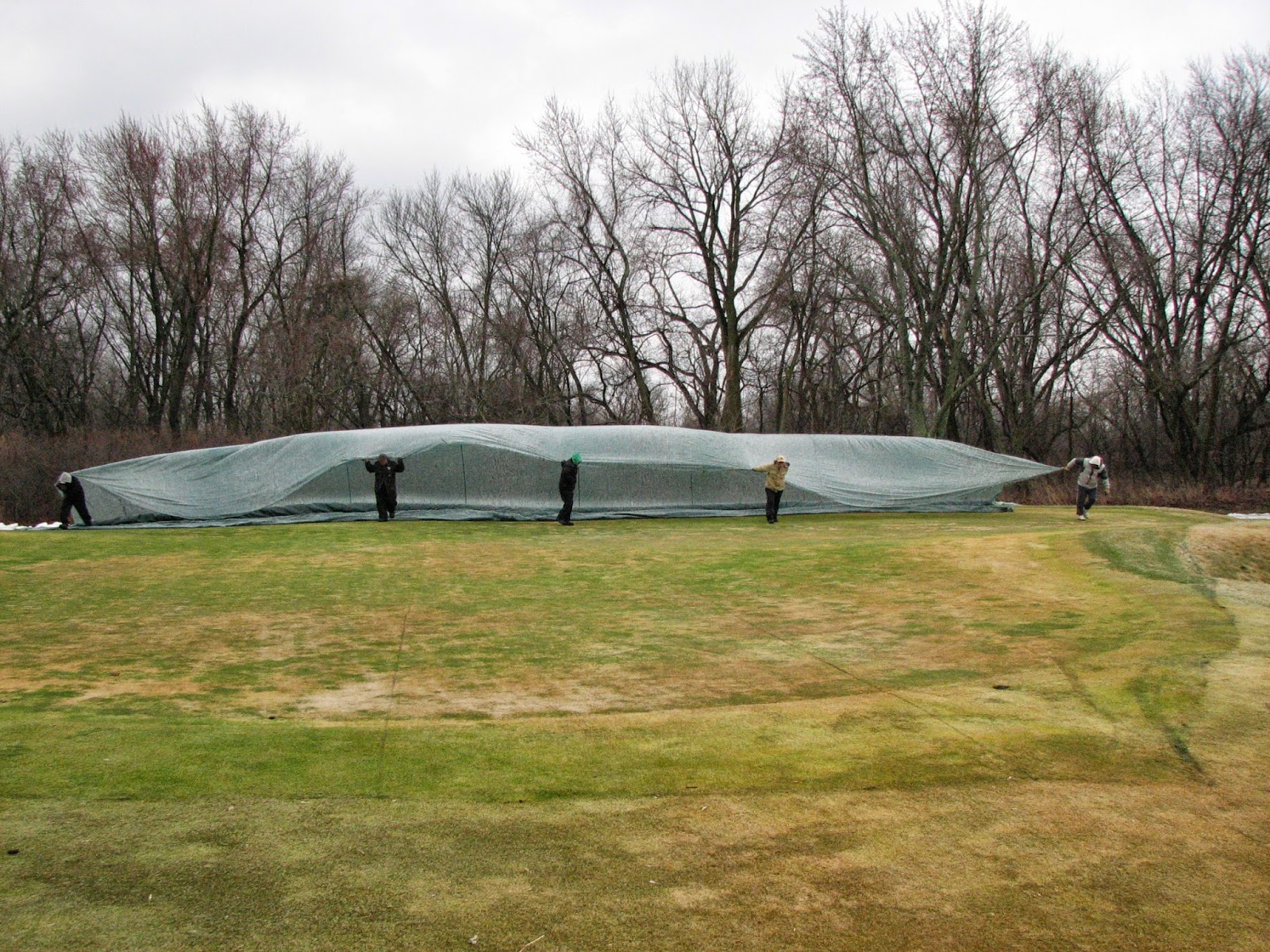We have made good progress on many greens and where we started the season with just 3 greens open for play we are now at 8. Specifically Nos. 5,8,12,13,14,15,16,18. More are getting close, like Nos. 1, 2, 10 (10days -2weeks - but no promises!) and others, Nos. 4,9,17 a few more weeks and finally Nos. 3,6,7,11 which will be longer yet. Warmth, germination, normal turf growth and spreading, plug planting from our turf nursery (when coverage is close to full we will finish it up with plugs -which we are working on everyday too) are all needed and will come, slowly but surely.
This large scale overseeding repair we've had to do will unfortunately create conditions you are not accustomed to as we move forward this year. The new seedlings will need time to establish and mature and will initially be fragile and prone to damage.
The following are practices we will need to employ to insure establishment:
-Mowing heights will need to be kept higher than normal. The new seedlings need leaves for photosynthesis and we don't want to cut them too low to jeopardize this.
-Rolling will need to be minimized until plants have developed so we don't crush and damage them.
-Grooming practices (light daily vertical mowing) will need to be withheld to minimize damage.
-Watering will need to be done as needed to keep seedbed moist and may be needed multiple times on warmer, drier, windier days.
-Seedhead suppression products (certain growth regulators) will need to be withheld. In a typical year we use these to suppress Poa annua seedhead development which are unsightly and wreak havoc on ball roll creating bumpy conditions. These will affect germination and establishment of our planted seed and we cannot use them this year. We did and will continue to use on the minimally damaged greens, but those with significant injury will not be treated.
Yes all of the above is painful! Slow, leafy, wet, bumpy, are not enjoyable and certainly are not typical for us but this is not a typical spring for us either. On greens that are healthy we can perform many of the above practices and even on portions of injured greens if areas are isolated, and eventually, slowly but surely, we will be able to return the practices to all greens.
Your patience and understanding of these unprecedented conditions are greatly appreciated.
Here's a look at how recovery is progressing:
No. 1 Making nice progress. Plugging work coming soon
#2. Much improvement. All photos look better from a distance but this is
only a short while from being open. Side Note: Note the 3 divot marks
at the lower portion of photo. Practicing right in front of a green!
I'll hold my tongue...or fingers, and say no more.
#3 Perimeter areas are hardest it. Will be some time before this can tolerate traffic.
#4 Swale area in center. some recovery from existing plants but much more needed.
#6 Drainage swale areas badly injured. Like #4 some recovery seen but will take more time here
#7 Most injured area of all greens. Interesting that this was where the former tree (back right behind green - removed last fall due to damage and deterioration) created shade and root competition weakening the turf on the green. Going forward with tree gone the new turf will be much healthier and likely better able to tolerate stresses.
#9 Making progress. Areas most impacted are where drainage is slow (plans are being formulated now to improve drainage on this and many other greens...more on this later) and where shade from the large trees front left of green and where nearly all traffic funnels to the 10th tee. Often it is several factors that result in turf being unable to tolerate cold or heat stresses. Poor drainage, shade, traffic, then ice... strike three...or four, you're out!
#10 Progressing well. This one along with #2, and #1 will be ready fairly soon.
#11 Most of damage is around perimeter areas. Clean-up pass stress?? Perhaps. #11 along with #3 are in about the same state of condition. Will be some time before play can resume.
#17 Going to be a little time here but perhaps several sod plugs will move us closer to opening. Lots of plugs being planted from our nursery to many of the damaged greens.
Slowly but surely we'll get things back to at least close to normal.
Thank you for your patience and understanding!
On a more fun note:
I mentioned in April 'Clippings' column that I was going to start a few honeybee hives. The hives are here (two near Grounds Op. Center, and one on course in tall grass near 14 Champ. tee) and I installed the bees on Apr. 8. We've done a lot of work in close proximity and they really don't want anything to do with us, just interested in gathering nectar and pollen. Honeybees have been subjected to many problems (varroa mites, habitat loss, improper or excessive insecticide use, and more) and perhaps we can help a little by caring for a few colonies. And perhaps we'll get a sweet reward in time.
My foray as a beekeeper with my first full inspection. They can be a little disturbed when their hive is opened up, hence the veil and white suit (apparently white is calming), and there are 10,000 at this point, which will grow to 60,000 or so, so I'll likely continue to use the veil! Many beekeepers eventually abandon the protective equipment, just shows that these girls (yes mostly females) aren't that sassy after all! My queens are in good shape and I've seen nectar and pollen being placed in the comb and tomorrow marks the 21st day which hopefully will show the first brood emerging.
And another fun note:
Hawks Win! Hawks Win!
Round One wrapped up with a 5-1 victory!
Bring on Round Two.
Let's Go Hawks!!!
































